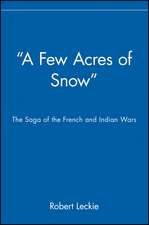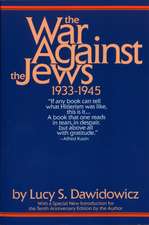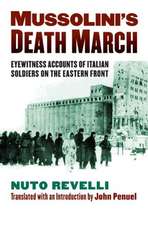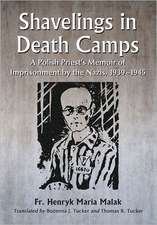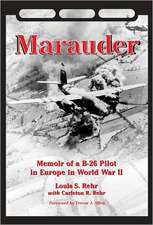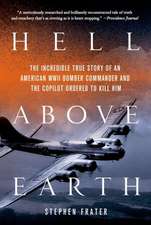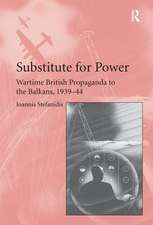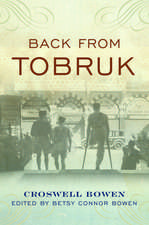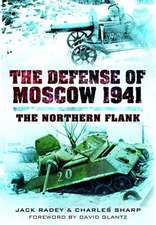Challenge for the Pacific: The Turning Point of the War
Autor Robert Leckieen Limba Engleză Paperback – 30 sep 2010
From Robert Leckie, the World War II veteran and New York Times bestselling author of Helmet for My Pillow, whose experiences were featured in the HBO miniseries The Pacific, comes this vivid narrative of the astonishing six-month campaign for Guadalcanal.
From the Japanese soldiers’ carefully calculated—and ultimately foiled—attempt to build a series of impregnable island forts on the ground to the tireless efforts of the Americans who struggled against a tenacious adversary and the temperature and terrain of the island itself, Robert Leckie captures the loneliness, the agony, and the heat of twenty-four-hour-a-day fighting on Guadalcanal. Combatants from both sides are brought to life: General Archer Vandegrift, who first assembled an amphibious strike force; Isoroku Yamamoto, the naval general whose innovative strategy was tested; the island-born Allied scout Jacob Vouza, who survived hideous torture to uncover the enemy’s plans; and Saburo Sakai, the ace flier who shot down American planes with astonishing ease.
Propelling the Allies to eventual victory, Guadalcanal was truly the turning point of the war. Challenge for the Pacific is an unparalleled, authoritative account of this great fight that forever changed our world.
Preț: 119.88 lei
Nou
Puncte Express: 180
Preț estimativ în valută:
22.94€ • 23.96$ • 19.02£
22.94€ • 23.96$ • 19.02£
Carte disponibilă
Livrare economică 21 ianuarie-04 februarie 25
Preluare comenzi: 021 569.72.76
Specificații
ISBN-13: 9780553386912
ISBN-10: 0553386913
Pagini: 442
Ilustrații: 7 MAPS
Dimensiuni: 136 x 200 x 26 mm
Greutate: 0.35 kg
Editura: Bantam
ISBN-10: 0553386913
Pagini: 442
Ilustrații: 7 MAPS
Dimensiuni: 136 x 200 x 26 mm
Greutate: 0.35 kg
Editura: Bantam
Extras
PART ONE: THE CHALLENGE
CHAPTER ONE
The admiral was tall, hard, and humorless. His face wasof flint and his will was of adamant. In the United States Navy which he commanded it was sometimes said, "He's so tough he shaves with a blow torch." President Roosevelt was fond of repeating this quip in the admiral's presence, hoping to produce, if there had been no reports of fresh disaster in the past twenty-four hours, that fleeting cold spasm of mirth-like an iceberg tick-which the President, the Prime Minister of England, and the admiral's colleagues on the Anglo-American Combined Chiefs of Staff were able to identify as a smile. If levity was rare in Admiral Ernest King, self-doubts or delusions were nonexistent. He was aware that he was respected rather than beloved by the Navy, and he knew that he was hated by roughly half of the chiefs of the Anglo-American alliance. Mr. Stimson, the U.S. Secretary of War, hated him; so did Winston Churchill and Field-Marshal Sir Alan Brooke and Admiral Sir Andrew Cunningham. Nevertheless, Admiral King continued to express the wish that was an athema in the ears of these men, as it was also irritating or at least unwelcome in the ears of General George Marshall, the U.S. Army Chief of Staff, and General H. H. Arnold, chief of the Army Air Force.
Admiral King wanted Japan checked. He wanted this even though he was bound to adhere to the grand strategy approved by Roosevelt and Churchill: concentrate on Hitler first while containing the Japanese. But what was containment? Containing the Japanese during the three months beginning with Pearl Harbor had been as easy as cornering a tornado. The Japanese hadcrippled the U.S. Pacific Fleet and all but driven Britain from the IndianOcean by sinking Prince of Wales and Repulse. Except for scattered American carrier strikes against the Gilberts and Marshalls the vast Pacific from Formosa to Hawaii was in danger of becoming a Japanese lake. Wake had fallen; Guam as well; the Philippines were on their way. Japan's "Greater East Asia Co-Prosperity Sphere" had already absorbed the Dutch East Indies withall their vast and precious deposits of oil and minerals, it had supplanted the French in Indochina and evicted the British from Singapore. Burma, Malaya, and Thailand were also Japanese. The unbreachable Malay Barrier had been broken almost as easily as the invincible Maginot Line had been turned.
Japan now looked west toward India with her hundreds of millions; and if Rommel should beat the British in North Africa, a German-Japanese juncture in the Middle Eastwould become a dreadful probability.
Meanwhile, great China was cut off andAustralia-to which General Douglas MacArthur had been ordered should he succeed in escaping from Corregidor-was threatened by a Japanese invasion of New Guinea. At that moment in early March, as Admiral King knew, the necessary invasion force was being gathered at Rabaul, the bastion which the Japanese were building on the eastern tip of New Britain. All this-all this ferocious speed and precision, all this lightning conquest, this sweeping of the seas and seizure of the skies-all this was containment? Admiral King did not think so. He thought it was rather creeping catastrophe. He thought that the Japanese, unchecked, would reach outagain. They would try to cut off Australia, drive deeper eastward toward Hawaii; and build an island barrier behind which they could drain off there sources of their huge new stolen empire. It was because King feared this eventuality that he had, as early as January 1942, when the drum roll of Japanese victories was beating loudest, moved to put a garrison of American troops on Fiji.
Already forging an island chain to Australia, he was still not satisfied: in mid-February he wrote to General Marshall urging that it wasessential to occupy additional islands "as rapidly as possible." The Chief of Staff did not reply for some time. When he did, he asked what King's purpose might be. The Navy Commander-in-Chief, Cominch as he was called, answered that he hoped to build a series of strong points from which a"step-by-step" advance might be made through the Solomon Islands against Rabaul. That was on March 2. Three days later, Admiral King addressed a memorandum to President Roosevelt. He outlined his plan of operations against the Japanese. He summarized them in three phrases: Hold Hawaii. Support Australasia. Drive northwestward from New Hebrides. Admiral Ernest King was not then aware of it, but he had at that moment put a tentative finger on an island named Guadalcanal. Japan was preparing to reach out again.
At Imperial General Headquarters in Tokyo the faces of the planners were bright with victory fever. Who could blame them, really? Who else might bask so long in such a sun of success without becoming slightly giddy? Of course, some of the officers of the Naval General Staff had passed from fever into delirium. Some of them-conscious that it was the Navy which had brought off the great stroke at Pearl Harbor, which had played the greater role in the other victories, which had shot the enemy aviators from the skies-some of them were proposing that Australia be invaded. The Navy's cooler heads found the proposal ridiculous. The men of the Army General Staff thought it was impossible. The Army, they explained, could never scrape together the ten divisions or more required for such an operation. The Navy officers nodded reflectively, saying nothing of their underlying suspicion that the Army, optimistic about Germany's chances against Russia that spring, was secretly hoarding its forces for use on the continent. The Army, as they knew, regarded the Soviet Union as the number one potential enemy. Therefore, the Army,looking northwestward, could not be expected to be enthusiastic about committing troops in the southeast.
So the Naval General Staff decided that instead ofinvading Australia it would be more feasible to isolate Australia. The flow of American war matériel to the island continent could be blocked by seizing eastern New Guinea and driving through the Solomons into the New Caledonia-Fijis area. What did the Army think of this? The Army approved. It promised to furnish its South Seas Detachment for the operation. These decisions also were reached in March. On the eighth day of that month, Lae and Salamaua in New Guinea were invaded. Two days later Finschhafen was occupied. Unknowingly, Imperial General Headquarters had pointed its baton at the island called Guadalcanal. Among the forces gathering for the operation to isolate Australia was the Japanese Navy's 25th Air Flotilla. Its mission was to hammer at Port Moresby, the big Allied base on New Guinea which lay only a few hundred miles north of the Australian continent.
But in early March the 25th Air Flotilla was understrength. One of its three components, and perhaps the best in quality,the Tainan Fighter Wing, was still far away on the fabled island of Bali in the East Indies. Orders were dispatched to Bali alerting the Tainan Wing for movement. Saburo Sakai was the crack pilot of the crack Tainan Fighter Wing. Saburo was not only a born fighter, he was born into a fightingcaste. He was a samurai, the scion of professional soldiers, and he could trace his ancestry to those samurai who had invaded Korea in the sixteenth century. Saburo regarded himself as a samurai even though that caste had been abolished by the great Emperor Meiji at the end of the last century. Saburo was proudthat his ancestors were among those haughty warriors of the city of Saga who had refused to give up their twin swords and had risen in revolt. And if, because of Imperial rescript, the proud and cruel samurai could no longer becruel, no longer swing their heavy two-handed sabers to sever, at a single slash, the body of some poor defenseless Eta or pariah who had offended them, they could always remain proud.
Saburo Sakai's people had remained proud,scratching out a bare subsistence on a tiny farm near Saga, still scorningmoney, still wearing the emblem of the two sabers symbolic of their caste, andstill priding themselves on their stoic indifference to pain and the strengthof their sword hands. Then, in the 1930s, the military adventurers seized power in Japan. The samurai was again in favor; his knightly code of bushido-a mixture of chivalry and cruelty-was adopted as the standard for all the young men of Japan.
In 1933, at the age of sixteen, Saburo enlisted in the Navy. Heendured the purposeful torture called "recruit training" in the Japanese Navy, went to sea on the battleships Kirishima and Haruna, applied forthe Navy Flier's School, and was accepted. Saburo, a youth of normal Japanese height, which is about a half foot shorter than that of the normal American, possessed an iron body.Though his nature was warm and good-humored, his will was of the same unbending metal. He became the outstanding student pilot of the year. He could hang by one arm from the top of a pole for half an hour, swim fifty meters in well under thirty seconds, stay underwater for two and a half minutes, and because a fighter pilot's movements need to be quick, he had so conditioned his reflexes that he could catch a fly in a single lightning lunge. At the end of 1937 Saburo was graduated as the outstanding student of the Thirty-eighth Non-Commissioned Officers Class. Of seventy-five handpicked candidates for that class, only twenty-five had survived. One day Japan would rue this policy of training only an elite of an elite, of providing itself with no reserve of skilled pilots to offset combatlosses, but in the Sino-Japanese War of the mid-1930s the Japanese pilots fought with such clear superiority as to indicate that they would have a long combat life indeed.
Saburo Sakai fought in that war. He became famous for his ardor and daring. Wounded once during a surprise enemy air raid, he ran for his plane streaming blood, taking off to pursue the Chinese bombers and to cripple one of them before he was forced to return to base. By December 7, 1941, Saburo Sakai was already an ace. He flew from Formosa in the first strikes against Clark Field in the Philippines. He was the first Japanese pilot to shoot down an American fighter over those islands. He was the first to flame a Flying Fortress, the very bomber piloted by Captain Colin Kelly, America's first war hero. By March of 1942, Saburo Sakai had shot down thirteen aircraft: Chinese,Russian, British, Dutch, and American. By that time also he and his comrades had reassembled at Bali. They were there to rest, but inactivity only made them restless. They became irritable. They fought with the soldiers who guarded their base. They drank or visited those brothels without which no Japanese military force can long endure. Saburo Sakai did neither, for he was a fighterpilot and a samurai who stuck to his code. Nevertheless, he also fretted,wondering if he would ever get home to see his family.
On March 12 came the great news. Rotation! The men with the longest time overseas were being relieved to go home, and Saburo had more time out than any of them. But the new leader of the Wing, Lieutenant Commander Tadashi Nakajima, did not call Saburo's name. Crushed, Saburo asked him if there had been a mistake. "No, you do not go home with the other men,"Nakajima said. "I need you, Sakai, to go with me. We are advancing to anew air base. It's Rabaul-on the island of New Britain-the foremost postagainst the enemy. You're the best pilot in the squadron, Sakai, and I want youto fly with me." There was no appeal, not for an enlisted man in theJapanese Navy. Heartbroken, Saburo Sakai became one of eighty pilots who were herded aboard a tiny, stinking, decrepit freighter for the 2500-mile voyage toRabaul. Only a 1000-ton subchaser escorted them. Indifferent to human suffering, and therefore blind to human value, Japan had placed a good portion of her finest naval fliers aboard a rusty old derelict and exposed them to the very real peril of a single torpedo or 500-pound bomb. But the rattler made Rabaul. It entered spacious,horseshoe-shaped Simpson Harbor and discharged its passengers.
The pilots were appalled. Vunakanau Airfield was little more than a narrow, dusty airstrip setin the shadow of a live volcano. From time to time a deep rumbling shook thefield and smoke and stones spouted from the crater's mouth. Nevertheless the men took heart when a sea plane tender delivered twenty of the latest models ofthe Zero fighter. They went back into action, and Saburo Sakai was again the scourge of the enemy. He flew on fighter sweeps to Port Moresby or escorted twin-engine "Betty" bombers on raiding forays over the big Allied base, and he shot down enemy planes with astonishing ease. The American P-39s and P-40s-Bell Airacobras and Curtiss Warhawks-were no match for the Japanese Zeros. The Zero was faster and much more maneuverable; and no one could cut inside an enemy fighter's turn so sharply as Saburo Sakai, bringing the American or Australian pilot under the full aimed fire of twin 20-mm. cannon and a pair of light machine guns. Saburo's squadron always flew west toward New Guinea.
But there were other planes of the 25th Air Flotilla which flew southeast to the Solomon Islands. Beginning with big Bougainville about two hundred miles southeast of Rabaul, the Solomons run on a southeast tangent for roughly another four hundred miles. They form a double chain of islands-actually the peaks of a great drowned mountain range-facing each other at near-regular intervals across a straight blue channel from twenty to one hundred miles wide. The objective of the Japanese bombers was the tiny islandof Tulagi, the site of the headquarters of the British Resident Commissioner-for Britain held the Southern Solomons-and now used by the Royal Australian Air Force as a sea plane base.
There was also a radio station onTulagi. The Japanese bombed it regularly. They could not know that their explosives were merely convulsing the rubble of ancient and inadequate radio equipment. The operator, a retired Australian seaman named Sexton, had continually complained to headquarters: "If the Japs come here and ask me where the radio station is, and I show them this, they'll shoot me for concealing the real one."6 Tulagi had an excellent anchorage, formed between the island's northern shore and the bigger bulk of Florida Island to the north. Sometimes, after the Japanese pilots had watched their bomb-hits making yellow mushrooms on the radio station, or their misses forming white rings in theblack of the bay, they banked lazily to fly low over a large long island twenty miles directly across the channel behind or to the south of Tulagi-Florida.Seen from the sky, it was a beautiful island; about ninety miles in length and twenty-five at its widewaist, and traversed end to end by lofty mountains, some as high as 8000 feet.The mountains crowded steeply down to the sea on Guadalcanal's southern or weather coast, abruptly joining reefs and rocks where a thunderous tall surf pounded eternally: no boats could land on that coast, and very few could hold at anchor there. But the northern coast, ah!, there was a long and gentle shore upon which the smallest boats might beach.
CHAPTER ONE
The admiral was tall, hard, and humorless. His face wasof flint and his will was of adamant. In the United States Navy which he commanded it was sometimes said, "He's so tough he shaves with a blow torch." President Roosevelt was fond of repeating this quip in the admiral's presence, hoping to produce, if there had been no reports of fresh disaster in the past twenty-four hours, that fleeting cold spasm of mirth-like an iceberg tick-which the President, the Prime Minister of England, and the admiral's colleagues on the Anglo-American Combined Chiefs of Staff were able to identify as a smile. If levity was rare in Admiral Ernest King, self-doubts or delusions were nonexistent. He was aware that he was respected rather than beloved by the Navy, and he knew that he was hated by roughly half of the chiefs of the Anglo-American alliance. Mr. Stimson, the U.S. Secretary of War, hated him; so did Winston Churchill and Field-Marshal Sir Alan Brooke and Admiral Sir Andrew Cunningham. Nevertheless, Admiral King continued to express the wish that was an athema in the ears of these men, as it was also irritating or at least unwelcome in the ears of General George Marshall, the U.S. Army Chief of Staff, and General H. H. Arnold, chief of the Army Air Force.
Admiral King wanted Japan checked. He wanted this even though he was bound to adhere to the grand strategy approved by Roosevelt and Churchill: concentrate on Hitler first while containing the Japanese. But what was containment? Containing the Japanese during the three months beginning with Pearl Harbor had been as easy as cornering a tornado. The Japanese hadcrippled the U.S. Pacific Fleet and all but driven Britain from the IndianOcean by sinking Prince of Wales and Repulse. Except for scattered American carrier strikes against the Gilberts and Marshalls the vast Pacific from Formosa to Hawaii was in danger of becoming a Japanese lake. Wake had fallen; Guam as well; the Philippines were on their way. Japan's "Greater East Asia Co-Prosperity Sphere" had already absorbed the Dutch East Indies withall their vast and precious deposits of oil and minerals, it had supplanted the French in Indochina and evicted the British from Singapore. Burma, Malaya, and Thailand were also Japanese. The unbreachable Malay Barrier had been broken almost as easily as the invincible Maginot Line had been turned.
Japan now looked west toward India with her hundreds of millions; and if Rommel should beat the British in North Africa, a German-Japanese juncture in the Middle Eastwould become a dreadful probability.
Meanwhile, great China was cut off andAustralia-to which General Douglas MacArthur had been ordered should he succeed in escaping from Corregidor-was threatened by a Japanese invasion of New Guinea. At that moment in early March, as Admiral King knew, the necessary invasion force was being gathered at Rabaul, the bastion which the Japanese were building on the eastern tip of New Britain. All this-all this ferocious speed and precision, all this lightning conquest, this sweeping of the seas and seizure of the skies-all this was containment? Admiral King did not think so. He thought it was rather creeping catastrophe. He thought that the Japanese, unchecked, would reach outagain. They would try to cut off Australia, drive deeper eastward toward Hawaii; and build an island barrier behind which they could drain off there sources of their huge new stolen empire. It was because King feared this eventuality that he had, as early as January 1942, when the drum roll of Japanese victories was beating loudest, moved to put a garrison of American troops on Fiji.
Already forging an island chain to Australia, he was still not satisfied: in mid-February he wrote to General Marshall urging that it wasessential to occupy additional islands "as rapidly as possible." The Chief of Staff did not reply for some time. When he did, he asked what King's purpose might be. The Navy Commander-in-Chief, Cominch as he was called, answered that he hoped to build a series of strong points from which a"step-by-step" advance might be made through the Solomon Islands against Rabaul. That was on March 2. Three days later, Admiral King addressed a memorandum to President Roosevelt. He outlined his plan of operations against the Japanese. He summarized them in three phrases: Hold Hawaii. Support Australasia. Drive northwestward from New Hebrides. Admiral Ernest King was not then aware of it, but he had at that moment put a tentative finger on an island named Guadalcanal. Japan was preparing to reach out again.
At Imperial General Headquarters in Tokyo the faces of the planners were bright with victory fever. Who could blame them, really? Who else might bask so long in such a sun of success without becoming slightly giddy? Of course, some of the officers of the Naval General Staff had passed from fever into delirium. Some of them-conscious that it was the Navy which had brought off the great stroke at Pearl Harbor, which had played the greater role in the other victories, which had shot the enemy aviators from the skies-some of them were proposing that Australia be invaded. The Navy's cooler heads found the proposal ridiculous. The men of the Army General Staff thought it was impossible. The Army, they explained, could never scrape together the ten divisions or more required for such an operation. The Navy officers nodded reflectively, saying nothing of their underlying suspicion that the Army, optimistic about Germany's chances against Russia that spring, was secretly hoarding its forces for use on the continent. The Army, as they knew, regarded the Soviet Union as the number one potential enemy. Therefore, the Army,looking northwestward, could not be expected to be enthusiastic about committing troops in the southeast.
So the Naval General Staff decided that instead ofinvading Australia it would be more feasible to isolate Australia. The flow of American war matériel to the island continent could be blocked by seizing eastern New Guinea and driving through the Solomons into the New Caledonia-Fijis area. What did the Army think of this? The Army approved. It promised to furnish its South Seas Detachment for the operation. These decisions also were reached in March. On the eighth day of that month, Lae and Salamaua in New Guinea were invaded. Two days later Finschhafen was occupied. Unknowingly, Imperial General Headquarters had pointed its baton at the island called Guadalcanal. Among the forces gathering for the operation to isolate Australia was the Japanese Navy's 25th Air Flotilla. Its mission was to hammer at Port Moresby, the big Allied base on New Guinea which lay only a few hundred miles north of the Australian continent.
But in early March the 25th Air Flotilla was understrength. One of its three components, and perhaps the best in quality,the Tainan Fighter Wing, was still far away on the fabled island of Bali in the East Indies. Orders were dispatched to Bali alerting the Tainan Wing for movement. Saburo Sakai was the crack pilot of the crack Tainan Fighter Wing. Saburo was not only a born fighter, he was born into a fightingcaste. He was a samurai, the scion of professional soldiers, and he could trace his ancestry to those samurai who had invaded Korea in the sixteenth century. Saburo regarded himself as a samurai even though that caste had been abolished by the great Emperor Meiji at the end of the last century. Saburo was proudthat his ancestors were among those haughty warriors of the city of Saga who had refused to give up their twin swords and had risen in revolt. And if, because of Imperial rescript, the proud and cruel samurai could no longer becruel, no longer swing their heavy two-handed sabers to sever, at a single slash, the body of some poor defenseless Eta or pariah who had offended them, they could always remain proud.
Saburo Sakai's people had remained proud,scratching out a bare subsistence on a tiny farm near Saga, still scorningmoney, still wearing the emblem of the two sabers symbolic of their caste, andstill priding themselves on their stoic indifference to pain and the strengthof their sword hands. Then, in the 1930s, the military adventurers seized power in Japan. The samurai was again in favor; his knightly code of bushido-a mixture of chivalry and cruelty-was adopted as the standard for all the young men of Japan.
In 1933, at the age of sixteen, Saburo enlisted in the Navy. Heendured the purposeful torture called "recruit training" in the Japanese Navy, went to sea on the battleships Kirishima and Haruna, applied forthe Navy Flier's School, and was accepted. Saburo, a youth of normal Japanese height, which is about a half foot shorter than that of the normal American, possessed an iron body.Though his nature was warm and good-humored, his will was of the same unbending metal. He became the outstanding student pilot of the year. He could hang by one arm from the top of a pole for half an hour, swim fifty meters in well under thirty seconds, stay underwater for two and a half minutes, and because a fighter pilot's movements need to be quick, he had so conditioned his reflexes that he could catch a fly in a single lightning lunge. At the end of 1937 Saburo was graduated as the outstanding student of the Thirty-eighth Non-Commissioned Officers Class. Of seventy-five handpicked candidates for that class, only twenty-five had survived. One day Japan would rue this policy of training only an elite of an elite, of providing itself with no reserve of skilled pilots to offset combatlosses, but in the Sino-Japanese War of the mid-1930s the Japanese pilots fought with such clear superiority as to indicate that they would have a long combat life indeed.
Saburo Sakai fought in that war. He became famous for his ardor and daring. Wounded once during a surprise enemy air raid, he ran for his plane streaming blood, taking off to pursue the Chinese bombers and to cripple one of them before he was forced to return to base. By December 7, 1941, Saburo Sakai was already an ace. He flew from Formosa in the first strikes against Clark Field in the Philippines. He was the first Japanese pilot to shoot down an American fighter over those islands. He was the first to flame a Flying Fortress, the very bomber piloted by Captain Colin Kelly, America's first war hero. By March of 1942, Saburo Sakai had shot down thirteen aircraft: Chinese,Russian, British, Dutch, and American. By that time also he and his comrades had reassembled at Bali. They were there to rest, but inactivity only made them restless. They became irritable. They fought with the soldiers who guarded their base. They drank or visited those brothels without which no Japanese military force can long endure. Saburo Sakai did neither, for he was a fighterpilot and a samurai who stuck to his code. Nevertheless, he also fretted,wondering if he would ever get home to see his family.
On March 12 came the great news. Rotation! The men with the longest time overseas were being relieved to go home, and Saburo had more time out than any of them. But the new leader of the Wing, Lieutenant Commander Tadashi Nakajima, did not call Saburo's name. Crushed, Saburo asked him if there had been a mistake. "No, you do not go home with the other men,"Nakajima said. "I need you, Sakai, to go with me. We are advancing to anew air base. It's Rabaul-on the island of New Britain-the foremost postagainst the enemy. You're the best pilot in the squadron, Sakai, and I want youto fly with me." There was no appeal, not for an enlisted man in theJapanese Navy. Heartbroken, Saburo Sakai became one of eighty pilots who were herded aboard a tiny, stinking, decrepit freighter for the 2500-mile voyage toRabaul. Only a 1000-ton subchaser escorted them. Indifferent to human suffering, and therefore blind to human value, Japan had placed a good portion of her finest naval fliers aboard a rusty old derelict and exposed them to the very real peril of a single torpedo or 500-pound bomb. But the rattler made Rabaul. It entered spacious,horseshoe-shaped Simpson Harbor and discharged its passengers.
The pilots were appalled. Vunakanau Airfield was little more than a narrow, dusty airstrip setin the shadow of a live volcano. From time to time a deep rumbling shook thefield and smoke and stones spouted from the crater's mouth. Nevertheless the men took heart when a sea plane tender delivered twenty of the latest models ofthe Zero fighter. They went back into action, and Saburo Sakai was again the scourge of the enemy. He flew on fighter sweeps to Port Moresby or escorted twin-engine "Betty" bombers on raiding forays over the big Allied base, and he shot down enemy planes with astonishing ease. The American P-39s and P-40s-Bell Airacobras and Curtiss Warhawks-were no match for the Japanese Zeros. The Zero was faster and much more maneuverable; and no one could cut inside an enemy fighter's turn so sharply as Saburo Sakai, bringing the American or Australian pilot under the full aimed fire of twin 20-mm. cannon and a pair of light machine guns. Saburo's squadron always flew west toward New Guinea.
But there were other planes of the 25th Air Flotilla which flew southeast to the Solomon Islands. Beginning with big Bougainville about two hundred miles southeast of Rabaul, the Solomons run on a southeast tangent for roughly another four hundred miles. They form a double chain of islands-actually the peaks of a great drowned mountain range-facing each other at near-regular intervals across a straight blue channel from twenty to one hundred miles wide. The objective of the Japanese bombers was the tiny islandof Tulagi, the site of the headquarters of the British Resident Commissioner-for Britain held the Southern Solomons-and now used by the Royal Australian Air Force as a sea plane base.
There was also a radio station onTulagi. The Japanese bombed it regularly. They could not know that their explosives were merely convulsing the rubble of ancient and inadequate radio equipment. The operator, a retired Australian seaman named Sexton, had continually complained to headquarters: "If the Japs come here and ask me where the radio station is, and I show them this, they'll shoot me for concealing the real one."6 Tulagi had an excellent anchorage, formed between the island's northern shore and the bigger bulk of Florida Island to the north. Sometimes, after the Japanese pilots had watched their bomb-hits making yellow mushrooms on the radio station, or their misses forming white rings in theblack of the bay, they banked lazily to fly low over a large long island twenty miles directly across the channel behind or to the south of Tulagi-Florida.Seen from the sky, it was a beautiful island; about ninety miles in length and twenty-five at its widewaist, and traversed end to end by lofty mountains, some as high as 8000 feet.The mountains crowded steeply down to the sea on Guadalcanal's southern or weather coast, abruptly joining reefs and rocks where a thunderous tall surf pounded eternally: no boats could land on that coast, and very few could hold at anchor there. But the northern coast, ah!, there was a long and gentle shore upon which the smallest boats might beach.
Recenzii
“Leckie puts you in the foxhole.”—The New York Times Book Review
“Fast-paced and informative . . . Characters are very much alive on the printed page.”—Navy Times
“[A] stirring story of America’s survival in its grimmest hour . . . as readable and gripping as a novel.”—Patriot Ledger
“Fast-paced and informative . . . Characters are very much alive on the printed page.”—Navy Times
“[A] stirring story of America’s survival in its grimmest hour . . . as readable and gripping as a novel.”—Patriot Ledger
Descriere
From the World War II veteran and "New York Times"-bestselling author of "Helmet for My Pillow," whose experiences were featured in the HBO miniseries "The Pacific," comes this vivid narrative of the astonishing six-month campaign for Guadalcanal.






